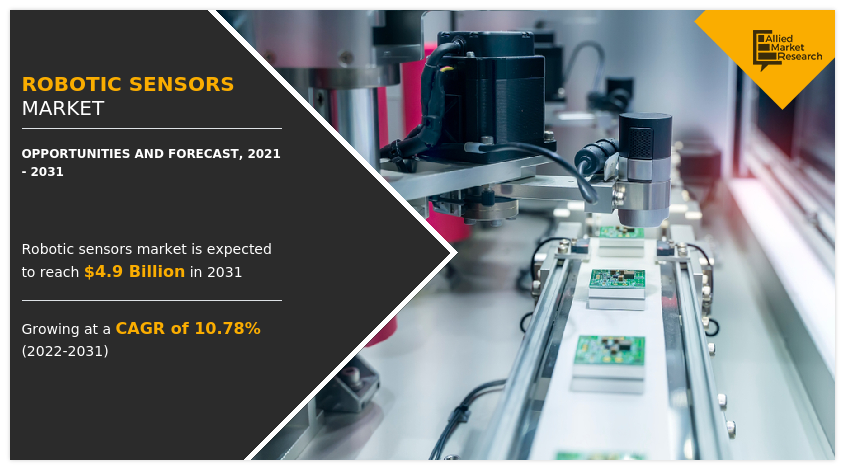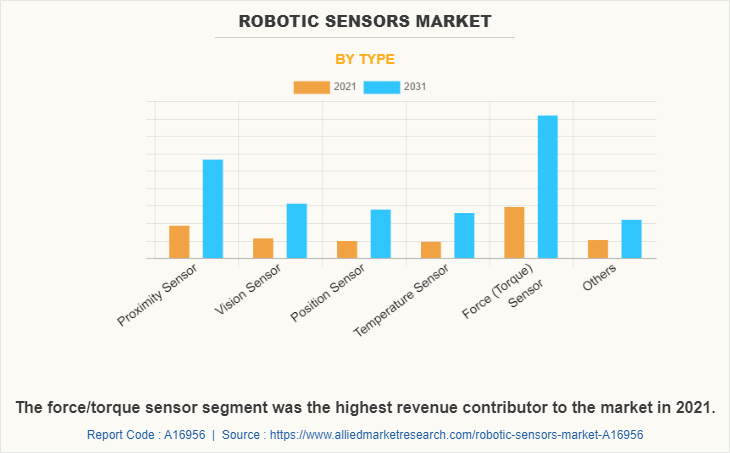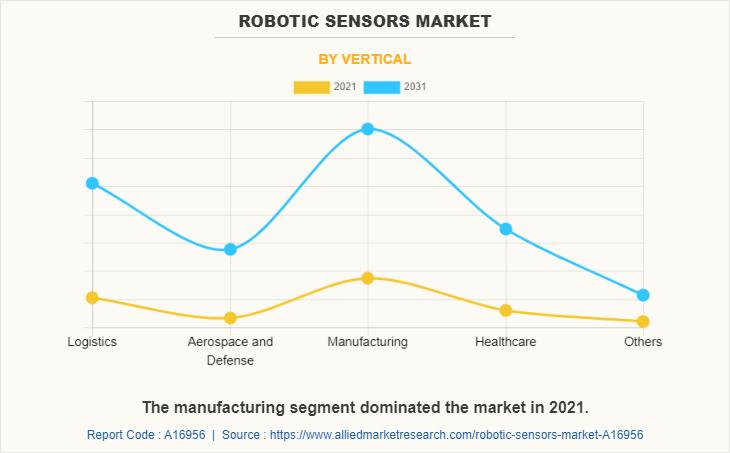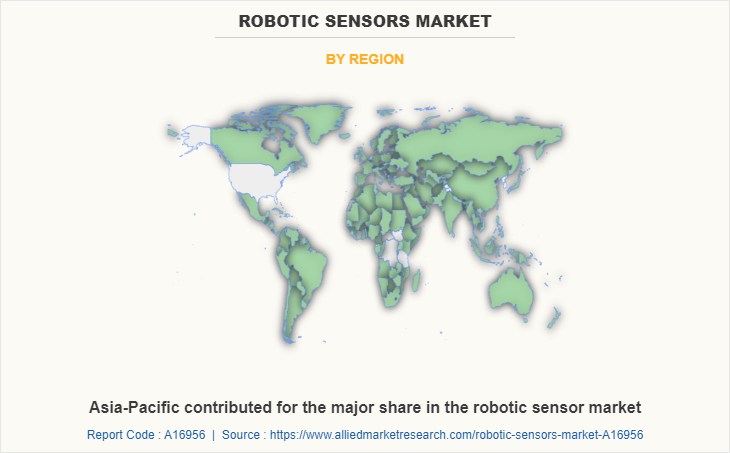Robotic Sensors Market Research 2031
The global robotic sensors market size was valued at $1.8 billion in 2021, and is projected to reach $4.9 billion by 2031, growing at a CAGR of 10.78% from 2022 to 2031. Robotic sensor is a device used to evaluate the environment in which the robot is operating and allows the robot to adjust actions based on collected data. The use of robots has increased significantly over the study period as a result of the advent of Industry 4.0 and digitization. The utilization of industrial robot sensors in robotics is anticipated to grow rapidly during the forecast period as robotics developments lead to flexible production models. Furthermore, robotic sensors industry is predicted to witness notable demand as autonomous and collaborative robot deployment increases across end-user sectors. Rise in need for automation and safety in organization and availability of affordable, energy-efficient robots drive the growth of robotic sensors market share. In addition, rise in labor & energy costs and increase usage of robotic sensor in different industry vertical fuel the growth in robotic sensors market forecast.
However, limited shelf life associated with robotic sensors may hinder the robotic sensors market outlook. Furthermore, growth in adoption of robotics technology in emerging economies and increase use in adverse applications are expected to provide lucrative opportunities for the robotic sensors market growth.

The global robotic sensors industry is segmented into type, vertical, and region.

By type, the market is segregated into force/torque sensor, proximity sensor, vision sensor, position sensor, temperature sensor, and others.The force (torque) sensor segment was the highest revenue contributor to the market, with $589.3 million in 2021, and is estimated to reach $1,635.6 million by 2031, with a CAGR of 10.87%. The proximity sensor dominated the market, in terms of revenue, in 2021, and is expected to follow the same trend during the forecast period.

On the basis of vertical, the market is fragmented into logistics, defense and aerospace, manufacturing, healthcare, and others.On the basis of vertical, the market is fragmented into logistics, defense and aerospace, manufacturing, healthcare, and others. The manufacturing segment dominated the market with $549.2 million in 2021, and is estimated to reach $1,602.9 million by 2031, with a CAGR of 11.43%.

Region wise, the robotic sensor market trends are analyzed across North America (the U.S., Canada, and Mexico), Europe (UK, Germany, France, and rest of Europe), Asia-Pacific China, Japan, India, South Korea, and rest of Asia-Pacific), and LAMEA (Latin America, the Middle East, and Africa). Asia-Pacific, specifically the China, remains a significant participant in the global robotic sensor industry. Major organizations and government institutions in the country are intensely putting resources into these sensors.
Top Impacting Factors
The market top impacting factors include rise in need for automation and safety in organization and availability of affordable, energy-efficient robots. In addition, rise in labor & energy costs and increase usage of robot touch sensor in different industry verticals impact the growth of the market. Furthermore, the market growth is affected by limited shelf life associated with robotic sensors. In addition, increase in investments in aerospace robotics influence the market growth. However, each of these factors is expected to have a definite impact on the growth of the market in the coming years.
Competition Analysis
The key players profiled in this report include Baumer group, Fanuc Corporation, FUTEK Advanced Sensor Technology, Inc., Honeywell International Inc., ATI Industrial Automation, Inc., Infineon Technologies AG, OMRON Corporation, Sensata Technologies, Inc., TE Connectivity Ltd., Tekscan, Inc., Keyence Corporation, Cognex Corporation, Ifm Electronic, and Schneider Electric. These key players have adopted strategies, such as product portfolio expansion, mergers & acquisitions, agreements, regional expansion, and collaborations to enhance their market penetration.
Key Benefits For Stakeholders
- This study comprises analytical depiction of the robotic sensors market opportunity along with the current trends and future estimations to depict the imminent investment pockets.
- The overall robotic sensor market share analysis is determined to understand the profitable trends to gain a stronger foothold.
- The report presents information related to key drivers, restraints, and opportunities with a detailed impact analysis.
- The robotic sensors market analysis is quantitatively analyzed from 2022 to 2031 to benchmark the financial competency.
- The Porter’s five forces analysis illustrates the potency of the buyers and suppliers in the smart display.
- The report includes the share of key vendors and robotic sensors market trends.
Robotic Sensors Market Report Highlights
| Aspects | Details |
| By Type |
|
| By Vertical |
|
| By Region |
|
| Key Market Players | FANUC CORPORATION, futek advanced sensor technology, inc., TE Connectivity Ltd., sensata technologies, inc., Honeywell International Inc., Infineon Technologies, Omron Corporation, baumer group, Tekscan, Inc., ATI Industrial Automation, Inc. |
Analyst Review
The robotic sensor market is anticipated to depict prominent growth during the forecast period, owing to increase in demand for advanced sensor for process automation across various industry verticals. In addition, surge in need for energy-efficient product is increased the deployment of energy-efficient robots across industries.
The robotic sensor market exhibits high growth potential in logistics and manufacturing sectors. The current business scenario has witnessed increase in demand for manufacturing of several components, particularly in the developing countries, such as China and India, owing to surge in population and rise in demand for sensors. The CXOs further added that companies in this industry have adopted various innovative techniques and strategies such as mergers and acquisitions to strengthen their business position in the competitive matrix. For instance, Novanta officially acquired ATI Industrial Automation in 2021. Novanta is a leader in mission-critical technologies to medical and advanced industrial equipment manufacturers.
The market growth is supplemented by proactive industrialization efforts and surge in manufacturing output, owing to technological advancements. These factors have allowed emerging markets to evolve as largest markets during the forecast period, both from demand and supply sides. Public and private organizations have substantially invested in R&D activities and fabrication techniques to develop cost-effective robotic sensors.
Surge in adoption of industrial robots in automotive manufacturing is anticipated to drive the growth and growing penetration of industrial robots across production facilities are some of the upcoming trends of the robotic sensor market in the world.
The manufacturing sector is the leading application of the robotic sensor market.
Asia Pacific is the leading player in the robotic sensor market.
The global robotic sensors market was valued at $1,780.2 million in 2021.
ATI Industrial Automation, Inc.,TE Connectivity, Fanuc Corporation, Baumer group, are the top companies to hold the market share in robotic sensors market.
Loading Table Of Content...



